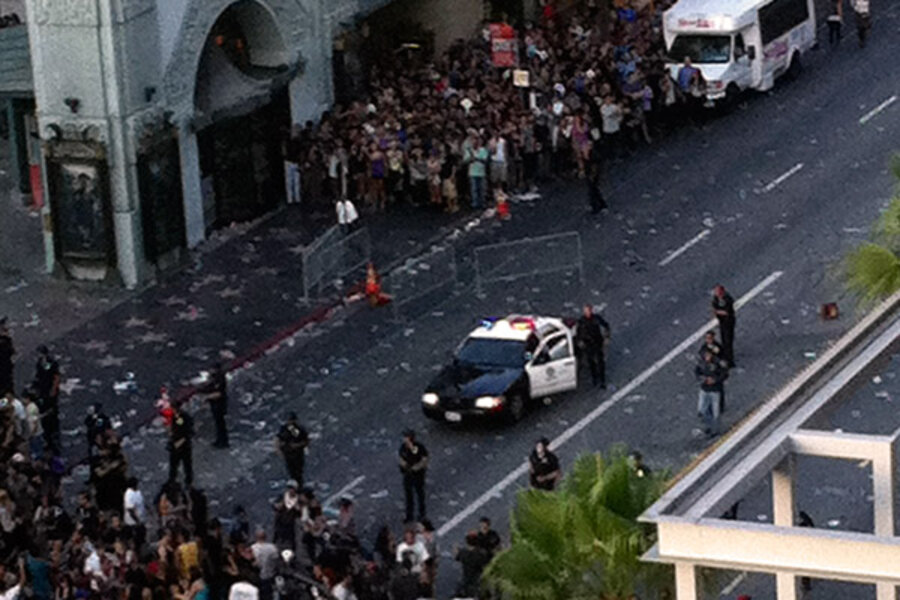Social media mayhem: when flash mobs go from benign to malign
Loading...
| Los Angeles
The unruly flash mob that brought police in riot gear to Hollywood’s Grauman Chinese Theater Wednesday night spotlights growing concerns being raised about the phenomenon of spontaneous, social-media-driven gatherings that turn from celebratory to destructive.
A crowd had assembled for the premier of a documentary about the Electric Daisy Carnival, an annual techno music festival that attracts tens of thousands of fans.
But the crowd outside the theater exploded to over 1,000 rowdy revelers, partly in response to a tweet sent out earlier in the afternoon by a DJ: “Let’s see if the magic of social networking will work today.”
Los Angeles Police Department officers responded to a request from a traffic cop on the scene after partiers refused to clear the streets for vehicles, says Hollywood division Sergeant Chad Costello, who notes that “in about a half hour it went from a small crowd to a large one.”
Four officers fired seven rounds of non-lethal, one-inch beanbags at a small group who were vandalizing a patrol car, he says, adding that the police response escalated as the crowd refused to disperse.
While many communities have struggled with criminal mobs gathered explicitly to loot or vandalize, many more find themselves wrestling with the challenge of the flash mob that starts out as benign but takes a turn for the malign.
“People have a right to assemble,” notes Officer Costello, but he adds, “they don’t have a right to let things get out of control so people get hurt.”
Communities around the globe are struggling to balance serendipity with social order.
Just this week, Cleveland’s City Council voted to bar social-media-driven flash mobs in the city’s parks, and officials in the German town of Braunschweig reportedly have banned them as well.
New media guru Paul Levinson, author of “New New Media,” says governmental regulation is not the answer. That doesn’t mean, however, there is nothing to be done.
The social response always lags behind the possibilities opened up by new technology, he says. First we discovered we could have thousands of “virtual” friends, thanks to the digisphere. Now, he points out, “it’s only natural that we want to take those new relationships back into the real, physical world.”
This ability to leverage innocent connections between vast numbers of people into a robust gathering in one spot can be a genuine challenge, as a Hamburg, Germany, 16-year-old found in June.
She had posted a modest party invitation on Facebook that inadvertently went public. Some 15,000 people responded, and 1,600 actually turned up at her house.
“We need to learn new skills as parents and consumers of social media,” says Mr. Levinson.
This is the mantra sounded by Drexel University youth violence expert Charles Williams, who has been helping Philadelphia address an ongoing rash of both criminal and unruly flash mobs.
Flashmobbers tend to be young, he notes, which means many are involved as a form of attention-getting typical of that demographic.
“So what happens is first they gather and if they don’t get the attention they want, then they start descending into worse and worse behavior,” he says, pointing to what he calls “acting-out” that typically occurs when police arrive on a scene.
Actions such as bottle-throwing and taunts can escalate into arrests and bodily injury and property damage. Breaking someone’s fingers might not be what the group intended, he says, but once the momentum of the crowd gets ugly, “bad things can start to happen.”
He and other experts point to the need for establishing new guidelines for new activities. Just as a parent would say to a child, “don’t touch the hot stove,” says Professor Williams, “they now have to teach kids not to do stupid things in the realm of social media.”





